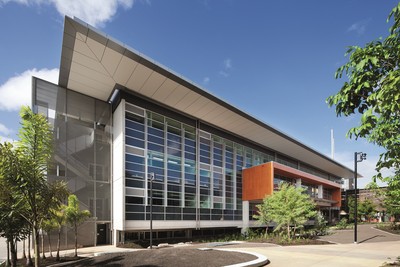Managing disasters at the emergency operations centre
Monday, 13 May, 2013
When a natural disaster or major incident occurs, it is vitally important that emergency services personnel have a safe and secure base from which to manage their response and recovery operations. With this requirement in mind, the Queensland Government has constructed a new emergency operations centre to provide front-line staff with enhanced capacity to meet increasing operational demands and to support large-scale disasters.
The Queensland Emergency Operations Centre (QEOC) houses the State Disaster Coordination Centre, State Operations Coordination Centre, 24-hour Emergency Management, Queensland Watch Desk, Queensland Ambulance Service (QAS) and Queensland Fire Rescue Service communications facilities, the Queensland Clinical Coordination Centre and the department’s Geographic Information Services.
To ensure essential services can perform their jobs to minimise the risk and impact of accidents, emergencies and disasters, the centre required a comprehensive, reliable electrical system, integrating lighting, heating, ventilation and air conditioning. The system had to be energy efficient, provide natural ventilation where possible and offer the highest practical occupant satisfaction rating, noting that many of the occupants would be working round the clock in very stressful situations. Electrical contractor Mark Bridger from Integrated Systems Group, a Clipsal Platinum Partner, was contracted to complete the integration of the project. Clipsal by Schneider Electric and Schneider Electric products were chosen for the project.
The QEOC comprises a three-building data and communications centre and a commercial office building. The centre has been designed to accommodate 60 staff during normal operations and 200 staff at peak demand periods.
Targeting a five star Green Star rating for the project, energy efficiency was a priority for the client. To help meet this objective, a Schneider Electric ION enterprise energy management system was fitted at the site. The PowerLogic ION meters can monitor and log devices, record analog and digital inputs, as well as send alerts to notify if there is a problem with the system.
The energy metering is operated through the Schneider Electric BMS and the installation of the system, integrated into the Schneider Electric low-voltage switchboard and circuit breakers, ensures the Queensland Emergency Operation Centre complies with the standards needed to gain efficiency accreditations.
In addition to the energy-efficiency reporting, the energy management system has also been utilised to rectify power quality issues at the site. Soon after the tenants moved into the building, they experienced power fluctuations, which were causing some concern. Through the ION enterprise system the cause of these fluctuations was identified and then resolved, saving the QEOC money and protecting their power requirements.
Schneider Electric uninterruptable power supplies were also used in the project to ensure that critical equipment is still able to be used in the event of a power outage.

Employee comfort is of the utmost importance, so a Clipsal by Schneider Electric C-Bus system with integrated lighting, blind control and light-harvesting sensors has been installed at the building to maintain a suitable working environment. General office lighting, which is controlled via Clipsal DSI dimmers wired through relays, has been dimmed to 90% output, while still maintaining an appropriate level of light in the area. This setting means that energy is being saved by not running the lights at full power.
In the QAS communications centre, the light fittings are more than 10 metres above the floor. To reduce any downtime incurred when the lamps need replacing, the light fittings have been split into two groups of six channels. Only one group of six channels is needed at a time, and a push-button switch has been installed so workers can easily and quickly swap between light groups.
This backup means that the first lighting group can be replaced in a prompt, but relaxed time frame. Each workstation has its own individual task lighting, operated via local motion sensors. After 10 minutes of inactivity at the workstation, the lights automatically switch off. Lights in the corridors between the communications building and the disaster management centre are controlled by a PE cell. Once the PE cell detects that natural lighting is below 200 lux, then lighting in the level-two walkway, the darkest walkway in the complex, is turned on. When the same PE cell detects that natural light has dropped below 100 lux, the rest of the walkway lighting is turned on. Similarly, a PE cell has been located on the roof of the communication building.
When the PE cell detects higher than 2000 lux, all blinds on the north side of the building drop down. Workers can raise the blinds manually after this point if they would prefer natural light. The blinds will only drop automatically once every day. In addition to this, the blind controls within these areas are on a key-lockable switch.
The C-Bus lighting has also been integrated into the Schneider Electric BMS system and a third-party security system. C-Bus links to the BMS via a BACNET gateway, with areas split into zones. Once any lighting group within a zone is on, a C-Bus command is sent to the BMS to turn on the relevant air-conditioning zone. Once all lighting groups within the zone are off, a C-Bus command is sent to the BMS to turn off the relevant air-conditioning zone. C-Bus integrates to the third-party security system via RS232 connections. Once a signal is received from the security panel indicating that the building is armed, C-Bus then turns off all lighting groups. In the event of a security breach, C-Bus turns on all lighting within the building.
What Australia thinks about the energy transition
A CSIRO survey has canvassed more than 6700 people in all states and territories, across capital...
NZ has reached the 'electrification tipping point' — where to now?
New Zealand is one the of the first countries in the world where electric appliances and vehicles...
Finding one faulty solar panel in a sea of millions
Up until now, finding faults in individual panels on a solar farm has been a time-consuming and...







